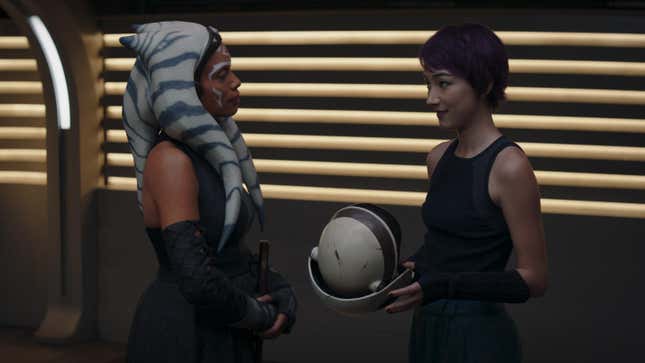
Dave Filoni loves Star Wars almost as much as he loves retconning it. In the animated series Star Wars: The Clone Wars, Filoni added context to the characters in a way that gave the much-maligned prequel trilogy a new emotional resonance. He addressed a lot of the complaints fans had and even brought fan-favorite Darth Maul back from the dead. Now, in his latest series, Ahsoka, it seems like George Lucas’ hand-picked apprentice is finally bringing balance to the Force. Which is to say he’s attempting to provide some cohesion to the many interpretations of the Force in Star Wars projects over the years.
The Force has been at the heart of Star Wars since Obi-Wan Kenobi explained it to Luke Skywalker (and the audience) for the first time in A New Hope. Everyone knows the iconic phrase “may the Force be with you,” yet even the creatives making Star Wars movies and TV shows can’t seem to agree on what exactly the Force is. Is it a power only certain sensitive users can tap into? Or is it an energy field flowing through every living thing? Is it strictly a light-side/dark-side dichotomy? Or is there something in between? Different filmmakers have had different answers to those questions. Even Lucas changed his mind and contradicted himself from time to time.
“The Force is what gives a Jedi his power”
The initial concept of the Force as laid out in the original trilogy was more of a spiritual or mystical power exclusively wielded by Jedis and those who had fallen to the dark side (the term “Sith” wasn’t officially part of the canon yet). Here’s how Obi-Wan describes it to Luke: “It is an energy field created by all living things. It surrounds us and penetrates us. It binds the galaxy together.” At this point in the timeline, most people believe it’s just religious nonsense, a reasonable assumption considering the few Jedi who are left are scattered and in hiding.
The only Jedi we see in the original trilogy are, of course, Obi-Wan, Yoda, and eventually Luke (not counting Force ghost Anakin), so the concept of the Force and how it can be used is fairly limited. It’s heavily implied that the ability is hereditary. “The Force is strong in my family,” Luke says. Some of the Force powers first depicted include the Jedi mind trick, telekinesis, telepathy, extra-sensory perception, and astral projection from beyond the grave. Other vague abilities are also referenced but not explained, like Obi-Wan sensing the destruction of Alderaan “as if millions of voices suddenly cried out in terror, and were suddenly silenced.” Lucas didn’t bother giving any scientific explanation for the Force this early on; that would come later, and it’s still a sore subject within the fandom.
“A microscopic life form that resides within all living cells”
In 1999, Lucas introduced the controversial concept of midi-chlorians in the prequel Star Wars: Episode I – The Phantom Menace. We didn’t really need a biological reason why some people were more sensitive to the Force than others, but we got one anyway. According to Qui-Gon Jinn, these tiny symbiotic and sentient creatures are able to connect to the Force and communicate its will to their hosts. They can create life, too. Young Anakin Skywalker doesn’t have a father; he’s a midi-chlorian miracle child. And he’s loaded with these life forms. Qui-Gon confirms this by stealing Anakin’s blood and testing it without his mother’s consent, a totally normal and non-problematic thing to do. Anyway, even after the Jedi Council learns that Anakin’s M-count is “off the charts,” they refuse to train him. For a supposedly wise group of Jedi masters, they really didn’t think that one through. Without Qui-Gon’s intervention, what was Anakin supposed to do? Wander around with 20,000 of these little guys inside his cells continuously speaking to him and just ... ignore them?
These were just some of the issues fans had with Phantom Menace (this is the movie that brought us Jar Jar Binks, after all), but the idea of midi-chlorians was so ridiculed that Lucas toned it way down in the next two films. It was too late to erase them from the canon, though. Even years later, when other creators like Dave Filoni brought the midi-chlorians back to the franchise, they remained an unpopular element that fans would rather just disregard.
“It’s true; the Force, the Jedi, all of it. It’s all true.”
The sequel trilogy and the standalone film Rogue One only muddied the concept of the Force even more. In Star Wars Episode VII – The Force Awakens, Rey is naturally gifted and able to use the Force without any training. Some fans took issue with that, calling her an overpowered Mary Sue (we don’t agree, but we’ll leave that argument for another time). She even holds her own in a lightsaber duel with Kylo Ren, a descendant of “the greatest Jedi who ever lived” (according to Filoni), who was trained by Luke Skywalker himself. Director and co-writer J.J. Abrams picked up and ran with many of Lucas’ ideas, but the midi-chlorians weren’t one of them. He had something else in mind to explain Rey’s innate abilities.
First, though, Rian Johnson would get a chance to put his own stamp on the galaxy with Star Wars: Episode VIII – The Last Jedi, which he wrote and directed. Johnson’s point of view was that aptitude with Force shouldn’t be restricted to any one family or the small pool of legacy characters we’ve already met. He democratized it, appearing to solve the mystery of Rey’s parentage by having Kylo Ren tell her they were no one. She’s just a random person born with the power to instinctively tap into the Force. To really drive home the theme that talent can come from anywhere, he gave us Broom Boy (official name: Temiri Blagg). After helping Finn and Rose escape Canto Bight, we see him listening to the tale of the resistance battling the First Order on Crait along with the other stable workers. Then he goes back to his sweeping, using the Force to lift his broom. Like hope, inspiration is contagious.
After Johnson’s zig, Abrams would zag right back in his conclusion to the sequel trilogy, Star Wars: Episode IX – The Rise Of Skywalker. When promoting the film, Abrams said of Johnson’s reference to burying the past, “It’s a bit of a meta approach to the story. I don’t think that people go to Star Wars to be told, ‘This doesn’t matter.’” That’s not the way a lot of fans interpreted it, but whatever. Abrams wanted Rey to be a Palpatine, so that’s what he made her. “Royalty of the dark side,” in his words. And we were back to the idea that prowess with the Force must be tied to a great house, or a long line of gifted Force users.

“I am one with the Force, and the Force is with me”
In between these installments, the standalone film Rogue One: A Star Wars Story gave us yet another take on the Force. We’d already seen Maz Kanata use the Force without being a Jedi, and here we get another example of someone outside the Jedi order who has a strong connection to it. Chirrut Îmwe is from a monastic sect called Guardians of the Whills, who worship the Force. These guys don’t see things in stark terms like light side and dark side, and are seeking balance instead. Though Chirrut, who is blind, has enhanced senses and fighting skills through training and discipline, he doesn’t use the Force the way a Jedi would. The character and his origins take us back to the spiritual aspects of the Force that we saw in the original trilogy. It wouldn’t be the last time we hear his famous chant, though.
“When you think you understand the Force, you realize just how little you know”
Ahsoka uses the same phrase as Chirrut in The Clone Wars when she’s trying to disable the inhibitor chip that caused her former Clone Trooper ally Rex to turn on her after Order 66: “I am one with the Force, and the Force is with me.” She’s left the Jedi order at this point, so it would make sense that she’d use this kind of Force invocation here. Or it’s possible Dave Filoni just really liked the phrase and wanted to use it again.
In The Clone Wars and Star Wars Rebels, Filoni expanded upon previous concepts of the Force in ways no one ever had before, with Lucas’ full support. As we mentioned earlier, he brought back midi-chlorians and even sent Yoda on a quest to their unnamed ancient planet of origin. There, Yoda learns of the Living Force and the Cosmic Force, two complementary but separate aspects of the energy field that binds the universe together. The lore gets very deep from here, and too complex to get into for now (we could do a whole separate essay on the Mortis gods alone). All you need to know is that Filoni has done a lot of thinking about the Force, where it comes from, and how it works. It’s with all these ideas floating around in his head that he approached the Ahsoka series.

“Talent is a factor. But training and focus are what truly define someone’s success.”
At first, Ahsoka taking on Sabine as her Padawan seems to go against everything we know about the Jedi and the Force. Sabine is not Force-sensitive, as Huyang points out every chance he gets. Ahsoka believes she’s capable of becoming a Jedi anyway. Or whatever passes for one in this era. Even Sabine has her doubts, though. “I can’t use the Force. I don’t feel it. Not like you do,” she tells Ahsoka. “The Force resides in all living things. Even you,” Ahsoka counters.
What Filoni is doing here is attempting to bring all the previous ideas about the Force together, into one Unified Force Theory that explains everything. The Force is in everyone, yes, but talent does make a difference. In other words, anyone can learn to play the cello with enough time and practice, but only a talented few will ever be good enough to play in a symphony orchestra, and fewer still will ever be as good as Yo-Yo Ma. Or if you prefer a physical comparison, Lucas himself once compared it to learning yoga or karate.
So, with this in mind, Johnson is right that the Force is accessible to everyone. Abrams is also right that a select few are capable of wielding it with great skill. Even M-count can be folded into this theory as the factor that determines that skill. We’ll have to see if Sabine gets any better at it, but we wouldn’t be surprised if she finally moves that cup by the end of season one. With the conditions for her to do so already set up by Filoni, it wouldn’t come out of nowhere. And it would finally bring the Force full circle.